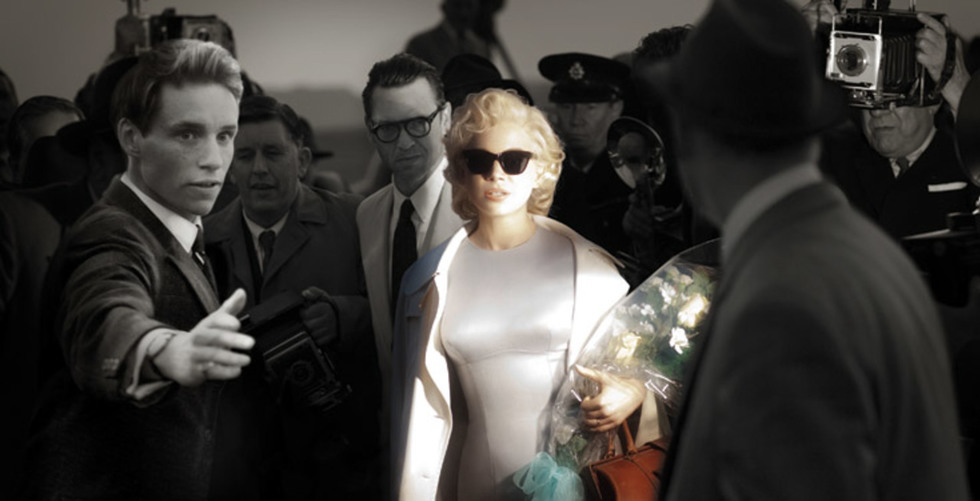
BY ZACHARY WIGON |
Michelle Williams as Marilyn Monroe: The Legend and the Lady
How does Simon Curtis’ lovely film My Week With Marilyn humanize the most famous actress of the 20th century?


As far as pop-culture iconography is concerned, Marilyn Monroe is more or less the apex; there isn’t a photo or image of her that doesn’t instantly conjure up all sorts of emotions and ideas – associations regarding sex symbols, patriarchal ideas of the feminine ideal, and our fame-obsessed culture all abound. Yet despite the fact that the field of thoughts surrounding Monroe is already heavily crowded, Simon Curtis and The Weinstein Company have stepped into the breach with My Week With Marilyn.
Starring Michelle Williams as the screen goddess, the film is based on two memoirs by one Colin Clark (played by Eddie Redmayne), a 3rd AD on Laurence Olivier’s Monroe-starring production of The Prince And The Showgirl. At the height of Monroe’s fame, she came to England to be validated as a serious actress alongside Olivier, and Clark, a 23-year-old son of the British upper class, improbably got the chance to spend some quality time with the icon. The film is ultimately their story, although it packs in larger-than-life supporting characters who were witness to the fracas that the film shoot, at times, became – Monroe’s husband Arthur Miller; Olivier’s wife, Vivien Leigh; and of course, Olivier himself, who is played by (who else?) Kenneth Branagh.
I had the chance to sit down with Curtis recently to discuss his film, which is garnering plenty of Oscar buzz for Williams’ performance.
Tribeca: Obviously, there’s a lot of iconography surrounding the idea of Marilyn Monroe. When you were thinking about representing her, how did you decide to approach her?
Simon Curtis: I don’t know if you really think in those terms. It’s a fair question, but when you’re directing it, I tried to sort of compress it, so it’s an actress playing a character. I mean, obviously it’s a character with tremendous associations, but on the day, you’re working with an actress on a particular scene. The other thing that was helpful was that we weren’t doing a biopic; we were doing a moment in Marilyn’s life, when she was 30. That helped concentrate the mind. I liked to reduce it to the most manageable challenge, rather than a big, amorphous challenge of playing an icon.
Tribeca: Right. And there are a few moments when you do trade in on her iconography, like with the musical numbers that bookend the film. When did that idea come in?
Simon Curtis: Late. I have my producer, Harvey [Weinstein], to thank for that. We discovered late in the making of the film just how brilliant a singer and dancer Michelle was. And also, because so much of the film is the peek behind the curtain of Marilyn, we wanted to provide a bit more for the audience of the Marilyn they expected to see.
Tribeca: And those bookends allow a kind of juxtaposition of her to come across, so they’re seeing not only her as a person but the legend as well.
Simon Curtis: Totally. It’s evident that most people under a certain age – and that age is probably fairly high – just know Marilyn as a famous name, or famous face. But they haven’t necessarily seen the performances. I was at this screening last week in Dallas, and someone came up to the usher and asked, “Is this where the Marilyn Monroe film is screening?” And the usher said, “Oh, that’s her surname, is it?” That’s the reality.
Tribeca: At what point did Michelle Williams come on?
Simon Curtis: Very early on. I had just started casting and the script was out there, and she wanted to meet. She’s an actress I’ve long admired. I was very thrilled. We set up a dialogue talking all things Marilyn – talking about 1956 and so on. She is a very smart person, and my job seemed to be to support her. I hope I was able to do that.

Tribeca: There’s this somewhat antiquated notion of the director telling the actors what they’re supposed to be thinking, feeling, doing, but when you’re working with an actress like Michelle Williams, one of the best, I guess it’s more of a situation where you say, how can I help you?
Simon Curtis: I think that’s very smart, and that’s right. I do think a director’s job is to work out how each actor feels you can help them. Sometimes it’s simply saying, “That’s great.” And also, enough actors know that if it is great, just let it be. Sometimes you look at a take and think, “Great, that’s it.”
Tribeca: Did Michelle watch all her old films?
Simon Curtis: Thoroughly.
Tribeca: It’s interesting, because there are moments where it’s like an imitation, the more performative stuff, but there’s a lot in there where we see a side of Marilyn that wasn’t publicly visible.
Simon Curtis: That’s right. I mean, there were four Marilyns, really – the songstress, the Marilyn of The Prince and The Showgirl, the private Marilyn, and the public Marilyn at the press conferences and so on. One way in for Michelle was learning the dance from The Prince and The Showgirl. Working with the choreographer, working out how Marilyn did the dance, via working out how Marilyn would have moved, was definitely a way in. And the memoirs were very helpful.
Tribeca: Tell me about Eddie Redmayne – how did he come to be involved?
Simon Curtis: He’s an actor I’ve known for a long time; he won a Tony last year. For someone so young, he’s done a lot of film and television work. He’s from the same school as Colin Clark, and has a wonderful blend of innocence and maturity.
Tribeca: It’s funny, if you think about it, if there ever were a young person who could handle being one-on-one with Marilyn Monroe, there’s something about the British aristocratic self-confidence that just doesn’t get fazed by anything.
Simon Curtis: Yes. [Colin] is from a very well connected family. He would have had Vivien Leigh and Olivier at Sunday lunch. But what you’re really saying is, even if he didn’t have that, he could’ve done it anyway, just being from that background, and I think that’s right.
Tribeca: How did you go about concocting the chemistry between Eddie and Michelle?
Simon Curtis: I don’t know, really – you talk about who each of them is, and who they are together, and you play the scenes. There’s an evolution of the relationship in the narrative, and you try to hit those beats. We had some rehearsal time, and had them getting to know each other a bit.

Tribeca: Kenneth Branagh was fantastic. It’s funny, there’s so much potential for it to go overboard, Branagh as Olivier, and yet –
Simon Curtis: But you could flip that around and say that’s why he’s so brilliant for it. So rather than that being a worry – because of his knowledge of Shakespeare, because of his knowledge about directing himself – it’s easy to forget just how experienced he is. He never stops working. I think some directors might have been intimidated by that, but I was just grateful. He had such an instinct for the character.
Tribeca: To go back to Marilyn for a moment – thinking about the adventures her character has in the film, it’s interesting – she’s 30 years old, and yet in many of the scenes, it feels like she’s a kid having fun.
Simon Curtis: I must admit, your questions are really good. That’s quite right. On one hand, we wanted that scene to feel erotically charged – skinny-dipping with Marilyn Monroe. On the other hand, they’re both aiming to recapture their childhood essence – in Marilyn’s case, a childhood she never really had. So for much of the film, I hope it’s working on two levels.
My Week With Marilyn opens Wednesday, November 23. Find tickets.
 Like My Week With Marilyn on Facebook.
Like My Week With Marilyn on Facebook.
 Check in to My Week With Marilyn on GetGlue.
Check in to My Week With Marilyn on GetGlue.
Watch the trailer:

